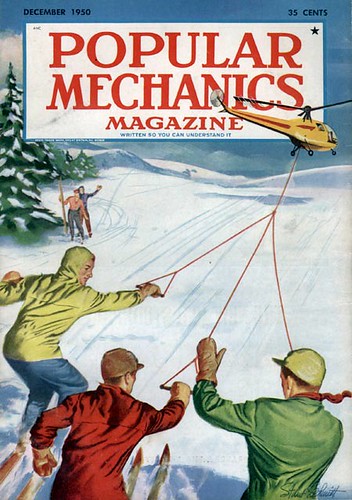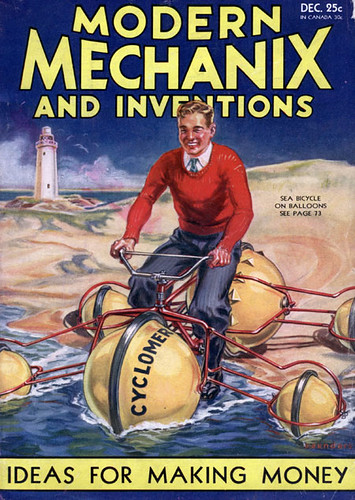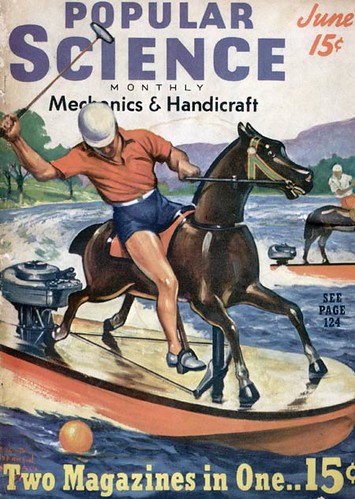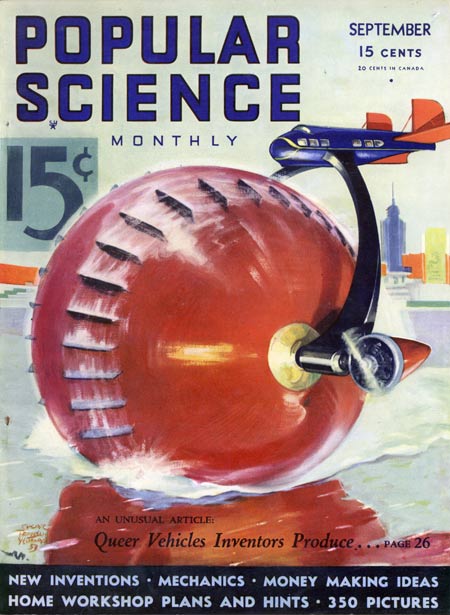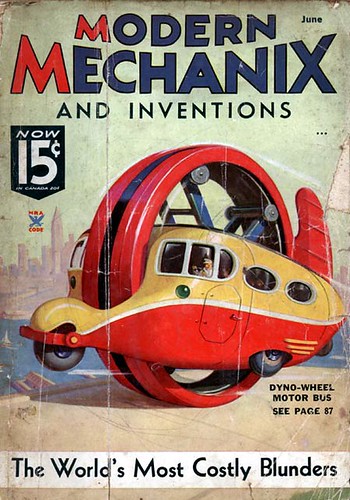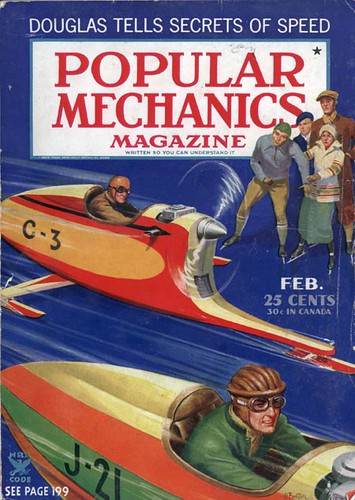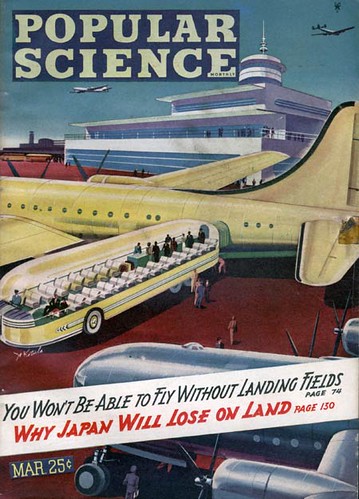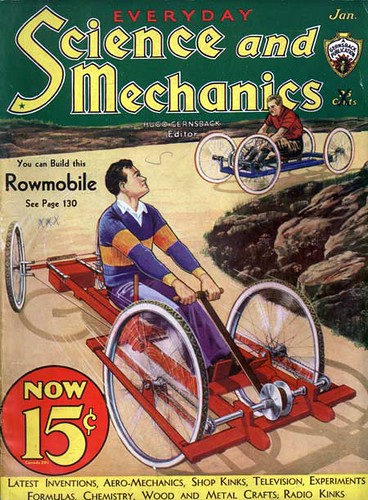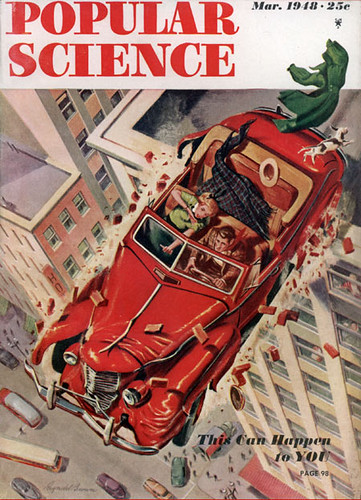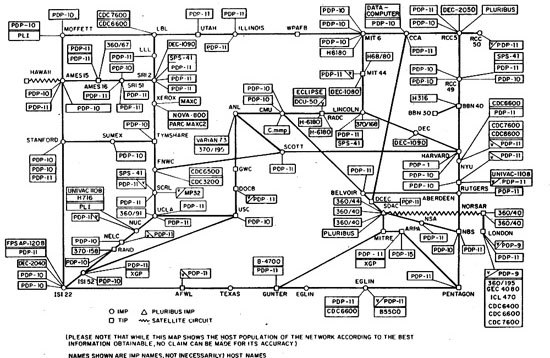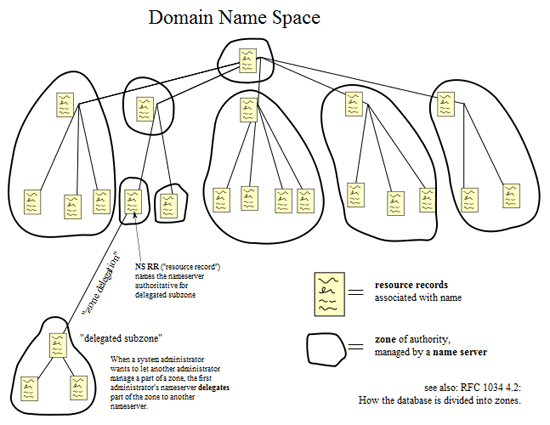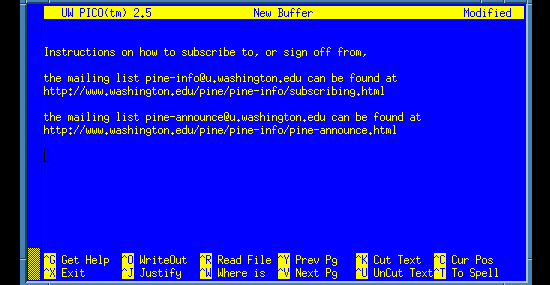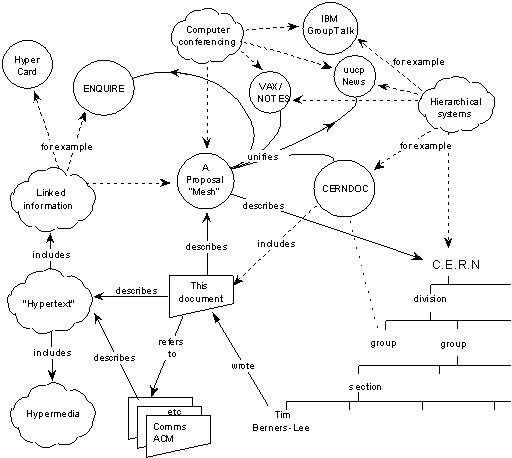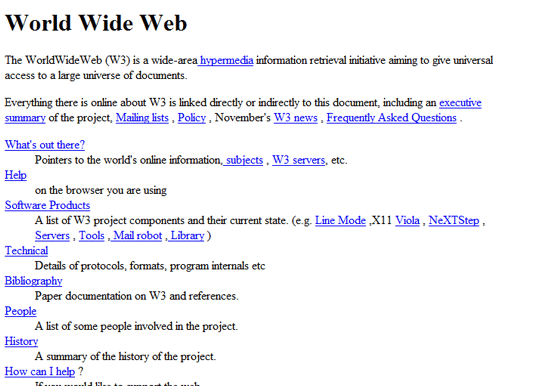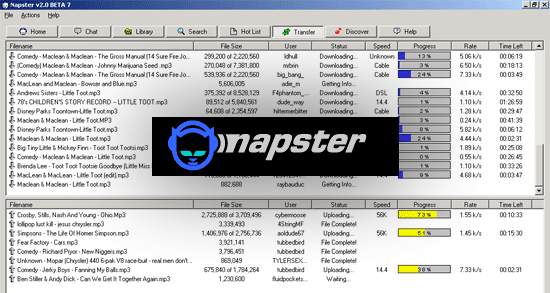Wednesday, December 16, 2009
Tuesday, December 15, 2009
10 Most Magnificent Trees in the World. – Neatorama
Posted by Alex in Neatorama Only on March 21, 2007 at 1:20 am. "A tree is a wonderful living organism which gives shelter, food, warmth and protection to all living things. It even gives shade to those who wield an axe to cut it down" – Buddha. There are probably hundreds of majestic and magnificent trees in the world – of these, some are particularly special: ...
"Thursday, December 10, 2009
Watch the PDC 2009 Keynotes
The keynote videos from day 1 and day 2 of PDC 2009 are now available.
The day 1 keynote features Ray Ozzie, Bob Muglia, and many other people coming on to present. This is the keynote talk where AppFabric was first announced.
The day 2 keynote features Steven Sinofsky and Scott Guthrie. If you're interested in Silverlight you'll particular want to watch this session.
More.Wednesday, December 9, 2009
What Was Popular Mechanics Thinking?
It's fun to peruse old copies of Popular Mechanics, Popular Science, Modern Mechanix, and similar magazines and laugh at the naivety of 1950s science. Everything was all, 'Rockets! Space! Lasers! Together at last, on your toaster!' Really, it was a recipe for an inevitable letdown when jet-packs failed to show up by 1970. But sometimes Popular Mechanics just had bad ideas. Like, crazy, poorly-thought-out contraptions and scenarios that, even in the '50s, made no damn sense whatsoever...
Helicopter Skiing? Have you ever seen a helicopter, guys? Unless this is some kind of magical 'no prop wash' chopper, those kids are going to be whipped around by a constant blizzard until the spiraling winds whip their tethers around their frozen, lifeless bodies and they're dragged through the Rockies. How would you even communicate to the pilot that you're ready to stop? He'd just go on sipping his coffee and plowing the mountainside with your icy corpse. No doubt the alarmed people emerging from the trees are trying to warn the boys of just this danger.
Why does this thing have wheels on the bottom, exactly? Is someone seriously taking the time to unhook the cables above, drive this to the airport, pick up vacationing tourists, drive back, reattach the gondola cabling, then use it to rappel over land flat enough that they could've just driven anyway? It says 'Skiway' on the side, but they're traveling above grass. The people on the ground aren't even wearing coats for cryin' out loud!
'Ideas for Making Money?' This is an idea for ruining your shoes, pal. Come on, this isn't even trying! The guy's already got his feet in the ocean and he's dressed like he's on his way to the Sears Portrait Studio. No way Aunt Edna is going to appreciate him showing up smelling like low tide and squishing sea water all over her carpet. And I'll admit I'm not up to date on a lot of hydrodynamics, but I'd be willing to be that front wheel/bubble turns into a face soaker in about two and a half seconds after launch.
Finally, a sport even more pompous than polo! Why, at this point, are we hanging on to the horse part of this equation? I mean really, I can understand some traditions and all, but there's nothing equestrian about riding carousel spare parts around a lake thwacking a beach ball with an extra long window squeegee. At least our boy in the foreground seems to have mastered how to ride. I can't say the same for the gentleman in the back.
Okay, this is tough to judge in terms of scale, but if that little airplane looking thing is supposed to be carrying people, I have to assume it sits atop a 150 feet tall hollow plastic ball with propeller engines on the sides. How is this practical on any level? How do people even get in that thing? When they reach their destination do they have a waiting platform or do they just leap out, lemming style, falling either into the surf or down to break their legs on a pier below?
Finally, jet packs! I can zoom around above the snarled traffic on my way to work and never get stuck on the offramp again! Except that the first time you turned this thing on your legs would instantly look like two little fish sticks that fell to the bottom of the oven and burned to a horrible black crisp. There's a reason you don't can't stand under the space shuttle to get a good view of the launch.
Apparently in the future we're ruled by a race of giant four-year-olds. If not, I have no idea how you're going to swipe this thing across the ground enough times to make it take off across the kitchen linoleum and into the floorboards. And let's say the 'Dyno-Wheel' is a perfectly legitimate mode of transportation (it's not): why do you have the other wheels, then? It sure seems like they're never going to touch the ground. Maybe this was just so enough people would associate 'car' with this thing and realize what they were looking at.
Holy crap. How did this get past Quality Control? First off, is this actually supposed to have military applications? I know this was back when Russia was pretty scary to everyone Stateside, but a fire engine red propeller on skis with an infantryman strapped to the front isn't very stealthy. Imagine a squad of 10 or 20 guys motor-skiing around the Siberian plains wondering why the enemy is always gone at least a half hour before they show up. Suppose they find some bad guys. Do they just park that thing and hop off? It's a pretty easy marker for a sniper down range. And what the hell happens if a guy lets go of the handles accidentally while he's moving? I have to assume he turns into an Army guy smoothie.
Why not just have a giant knife sticking off the front of this thing? Was that too subtle? These guys are already making it look dangerous; they're obviously moving at very high speed (see those streaks?) approximately a foot and a half away from a group of terrified skaters. You know, because if there's any surface that begs for an exposed propeller moving at extremely high speed near large groups of people, it's ice.
What is it with these guys and giant, exposed props? Jeez. You know what happens every time a plane sucks in a wayward bird? If everyone's lucky, it has an emergency landing and everyone has to get off because the exploding bird really does a number on the engines and they need to be either repaired or replaced. If everyone's not so lucky, the engine explodes and the plane crashes. You know why it doesn't happen as often as you might expect? There aren't a lot of birds at 30,000 feet. You have to go a lot lower, you know, like zipping across the road. Actually, forget birds, what happens the first time you rear end somebody and your propeller chews up the back end of the next guy's car and it looks just like that time my Great-Grandma ran over the rabbit den with the lawnmower?
In the future, planes will have genitals! I guess this ended up turning into the common airport shuttle, but I don't really get this scenario. Why do some of the people have to be secluded in what looks to be a windowless Twinkiemobile that docks with the plane like some sort of lunar lander? Is the atmosphere toxic? There are people outside the thing milling around trying to get in!
No sir, that's not a silent engine. That's a bong. We had combustion engines in the 1950s, right? How would having to light some sort of explosive fuel with an open flame just to cut your grass be seen as technological progress?
Finally, I can travel around town with all the convenience of rowing, one of the most physically demanding and exhausting activities known to man. Do these go backwards like traditional rowing would seem to indicate? Because we just went from 'useless exercise equipment' to 'high speed deathtrap' if that's the case. I don't even see a seatbelt over that guy's purple pants.
No, Popular Mechanics, that cannot happen to me. You know why? Because I don't go speeding around rooftops in my car. I'm not even sure how they got that thing on top of an office building. Even the poor dog is going to take a pretty nasty spill from this. And what future is this predicting, exactly? One in which this particular guy's bouts with alcoholism finally catch up to him? The future's a bummer.
"Microsoft SDK for Facebook Released
Microsoft has created an SDK to make it easier for you to write Facebook applications.
Resources
- Read the announcement.
- Find out more about the .NET Facebook SDK

Tuesday, December 8, 2009
Thursday, November 19, 2009
VP of Operations
Tuesday, November 17, 2009
Hey Look, We Know Nothing About The Apple Tablet!
 What is the Apple Tablet? It is beginning to take on the image of an anticipated Christmas present, only everyone has the same gift, and is at the same time wildly guessing what it might be. We have no idea, but we keep on talking about it.
What is the Apple Tablet? It is beginning to take on the image of an anticipated Christmas present, only everyone has the same gift, and is at the same time wildly guessing what it might be. We have no idea, but we keep on talking about it.
It seems that everyone so wants Apple to build a tablet, (why I have no idea, we have all always hated tablet computing, and refuse to buy any other tablet by any other company), that we are willing to invent endless tales about just what they might launch. It is the proverbial group whiteboard, everyone just draws their own images and writes about it.
You know what, I would find it very comical if Apple had no intention of ever building a tablet. But, to their credit, we have been talking about it for so long now, they could have conceivably began the project after the babble, and completed it in its current hype cycle, releasing it just at the tail end of the buzz to massive clamor. Apple, I never said that you were not brilliant.
But until we have at least some new credible rumor, can we all be quiet? Sure, it’s fun that CNN Money did a piece on the tablet, right? Not really, it was hundreds of words of endless fluff that was a mere rehash of what we already knew that we didn’t know. Its two scenarios: “Coolest Device.. Ever?” and “Or the Fizzle May Fail?” were both so oversimplified as to say nothing.
The most telling point in the article came with this: “It’s supposedly going to make its début in the next few months, and you can have it for the low, low price of $600. Or $800. Maybe $1,000. No one’s really sure.” Uh huh. So, you have no idea if and when it is going to be launched, and you have no idea what it will cost. Well, given that you have no idea what it will do, or if it exists, having no idea what it will (maybe) cost, makes sense.
If we did have a price, that would be interesting; we would at least have something to guess from. Until Apple tosses a bone, if they ever do make a Tablet, then we can talk. Until then, can we all put our pants back on and sit down? There is enough going on the tech that actually exists.
Rumors and speculation are important, and fun, parts of technology. Especially in technology reporting and blogging. What is not fun is rehashing the same set of non-facts for the tenth time. Stop kicking the horse, it has expired.
Monday, November 16, 2009
The History of the Internet in a Nutshell
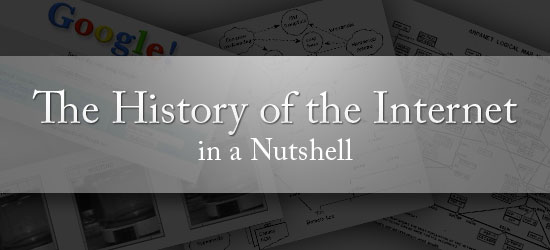
If you’re reading this article, it’s likely that you spend a fair amount of time online. However, considering how much of an influence the Internet has in our daily lives, how many of us actually know the story of how it got its start?
Here’s a brief history of the Internet, including important dates, people, projects, sites, and other information that should give you at least a partial picture of what this thing we call the Internet really is, and where it came from.
While the complete history of the Internet could easily fill a few books, this article should familiarize you with key milestones and events related to the growth and evolution of the Internet between 1969 to 2009.
1969: Arpanet
Arpanet was the first real network to run on packet switching technology (new at the time). On the October 29, 1969, computers at Stanford and UCLA connected for the first time. In effect, they were the first hosts on what would one day become the Internet.
The first message sent across the network was supposed to be "Login", but reportedly, the link between the two colleges crashed on the letter "g".
1969: Unix
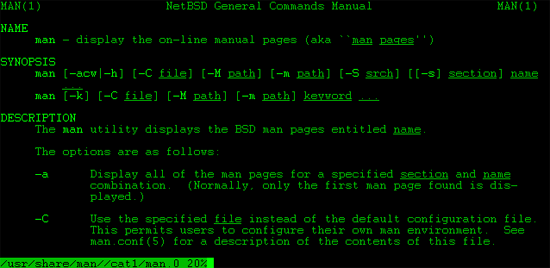
Another major milestone during the 60’s was the inception of Unix: the operating system whose design heavily influenced that of Linux and FreeBSD (the operating systems most popular in today’s web servers/web hosting services).
1970: Arpanet network
An Arpanet network was established between Harvard, MIT, and BBN (the company that created the "interface message processor" computers used to connect to the network) in 1970.
1971: Email

Email was first developed in 1971 by Ray Tomlinson, who also made the decision to use the "@" symbol to separate the user name from the computer name (which later on became the domain name).
1971: Project Gutenberg and eBooks
One of the most impressive developments of 1971 was the start of Project Gutenberg. Project Gutenberg, for those unfamiliar with the site, is a global effort to make books and documents in the public domain available electronically–for free–in a variety of eBook and electronic formats.
It began when Michael Hart gained access to a large block of computing time and came to the realization that the future of computers wasn’t in computing itself, but in the storage, retrieval and searching of information that, at the time, was only contained in libraries. He manually typed (no OCR at the time) the "Declaration of Independence" and launched Project Gutenberg to make information contained in books widely available in electronic form. In effect, this was the birth of the eBook.
1972: CYCLADES
France began its own Arpanet-like project in 1972, called CYCLADES. While Cyclades was eventually shut down, it did pioneer a key idea: the host computer should be responsible for data transmission rather than the network itself.
1973: The first trans-Atlantic connection and the popularity of emailing
Arpanet made its first trans-Atlantic connection in 1973, with the University College of London. During the same year, email accounted for 75% of all Arpanet network activity.
1974: The beginning of TCP/IP
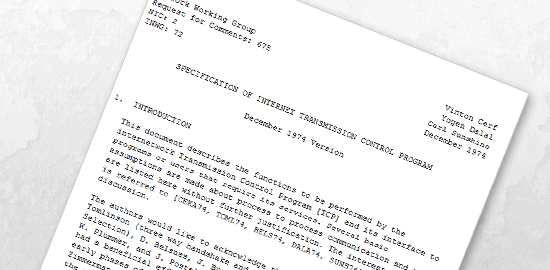
1974 was a breakthrough year. A proposal was published to link Arpa-like networks together into a so-called "inter-network", which would have no central control and would work around a transmission control protocol (which eventually became TCP/IP).
1975: The email client
With the popularity of emailing, the first modern email program was developed by John Vittal, a programmer at the University of Southern California in 1975. The biggest technological advance this program (called MSG) made was the addition of "Reply" and "Forward" functionality.
1977: The PC modem
1977 was a big year for the development of the Internet as we know it today. It’s the year the first PC modem, developed by Dennis Hayes and Dale Heatherington, was introduced and initially sold to computer hobbyists.
1978: The Bulletin Board System (BBS)
The first bulletin board system (BBS) was developed during a blizzard in Chicago in 1978.
1978: Spam is born
1978 is also the year that brought the first unsolicited commercial email message (later known as spam), sent out to 600 California Arpanet users by Gary Thuerk.
1979: MUD – The earliest form of multiplayer games
The precursor to World of Warcraft and Second Life was developed in 1979, and was called MUD (short for MultiUser Dungeon). MUDs were entirely text-based virtual worlds, combining elements of role-playing games, interactive, fiction, and online chat.
1979: Usenet
1979 also ushered into the scene: Usenet, created by two graduate students. Usenet was an internet-based discussion system, allowing people from around the globe to converse about the same topics by posting public messages categorized by newsgroups.
1980: ENQUIRE software
The European Organization for Nuclear Research (better known as CERN) launched ENQUIRE (written by Tim Berners-Lee), a hypertext program that allowed scientists at the particle physics lab to keep track of people, software, and projects using hypertext (hyperlinks).
1982: The first emoticon
![]()
While many people credit Kevin MacKenzie with the invention of the emoticon in 1979, it was Scott Fahlman in 1982 who proposed using :-) after a joke, rather than the original -) proposed by MacKenzie. The modern emoticon was born.
1983: Arpanet computers switch over to TCP/IP
January 1, 1983 was the deadline for Arpanet computers to switch over to the TCP/IP protocols developed by Vinton Cerf. A few hundred computers were affected by the switch. The name server was also developed in ‘83.
1984: Domain Name System (DNS)
The domain name system was created in 1984 along with the first Domain Name Servers (DNS). The domain name system was important in that it made addresses on the Internet more human-friendly compared to its numerical IP address counterparts. DNS servers allowed Internet users to type in an easy-to-remember domain name and then converted it to the IP address automatically.
1985: Virtual communities
1985 brought the development of The WELL (short for Whole Earth ‘Lectronic Link), one of the oldest virtual communities still in operation. It was developed by Stewart Brand and Larry Brilliant in February of ‘85. It started out as a community of the readers and writers of the Whole Earth Review and was an open but "remarkably literate and uninhibited intellectual gathering". Wired Magazine once called The Well "The most influential online community in the world."
1986: Protocol wars
The so-called Protocol wars began in 1986. European countries at that time were pursuing the Open Systems Interconnection (OSI), while the United States was using the Internet/Arpanet protocol, which eventually won out.
1987: The Internet grows
By 1987, there were nearly 30,000 hosts on the Internet. The original Arpanet protocol had been limited to 1,000 hosts, but the adoption of the TCP/IP standard made larger numbers of hosts possible.
1988: IRC – Internet Relay Chat
Also in 1988, Internet Relay Chat (IRC) was first deployed, paving the way for real-time chat and the instant messaging programs we use today.
1988: First major malicious internet-based attack
One of the first major Internet worms was released in 1988. Referred to as "The Morris Worm", it was written by Robert Tappan Morris and caused major interruptions across large parts of the Internet.
1989: AOL is launched
When Apple pulled out of the AppleLink program in 1989, the project was renamed and America Online was born. AOL, still in existence today, later on made the Internet popular amongst the average internet users.
1989: The proposal for the World Wide Web
1989 also brought about the proposal for the World Wide Web, written by Tim Berners-Lee. It was originally published in the March issue of MacWorld, and then redistributed in May 1990. It was written to persuade CERN that a global hypertext system was in CERN’s best interest. It was originally called "Mesh"; the term "World Wide Web" was coined while Berners-Lee was writing the code in 1990.
1990: First commercial dial-up ISP
1990 also brought about the first commercial dial-up Internet provider, The World. The same year, Arpanet ceased to exist.
1990: World Wide Web protocols finished
The code for the World Wide Web was written by Tim Berners-Lee, based on his proposal from the year before, along with the standards for HTML, HTTP, and URLs.
1991: First web page created
1991 brought some major innovations to the world of the Internet. The first web page was created and, much like the first email explained what email was, its purpose was to explain what the World Wide Web was.
1991: First content-based search protocol
Also in the same year, the first search protocol that examined file contents instead of just file names was launched, called Gopher.
1991: MP3 becomes a standard
Also, the MP3 file format was accepted as a standard in 1991. MP3 files, being highly compressed, later become a popular file format to share songs and entire albums via the internet.
1991: The first webcam

One of the more interesting developments of this era, though, was the first webcam. It was deployed at a Cambridge University computer lab, and its sole purpose was to monitor a particular coffee maker so that lab users could avoid wasted trips to an empty coffee pot.
1993: Mosaic – first graphical web browser for the general public
The first widely downloaded Internet browser, Mosaic, was released in 1993. While Mosaic wasn’t the first web browser, it is considered the first browser to make the Internet easily accessible to non-techies.
1993: Governments join in on the fun
In 1993, both the White House and the United Nations came online, marking the beginning of the .gov and .org domain names.
1994: Netscape Navigator
Mosaic’s first big competitor, Netscape Navigator, was released the year following (1994).
1995: Commercialization of the internet
1995 is often considered the first year the web became commercialized. While there were commercial enterprises online prior to ‘95, there were a few key developments that happened that year. First, SSL (Secure Sockets Layer) encryption was developed by Netscape, making it safer to conduct financial transactions (like credit card payments) online.
In addition, two major online businesses got their start the same year. The first sale on "Echo Bay" was made that year. Echo Bay later became eBay. Amazon.com also started in 1995, though it didn’t turn a profit for six years, until 2001.
1995: Geocities, the Vatican goes online, and JavaScript
Other major developments that year included the launch of Geocities (which officially closed down on October 26, 2009).
The Vatican also went online for the first time.
Java and JavaScript (originally called LiveScript by its creator, Brendan Eich, and deployed as part of the Netscape Navigator browser – see comments for explanation) was first introduced to the public in 1995. ActiveX was launched by Microsoft the following year.
1996: First web-based (webmail) service
In 1996, HoTMaiL (the capitalized letters are an homage to HTML), the first webmail service, was launched.
1997: The term "weblog" is coined
While the first blogs had been around for a few years in one form or another, 1997 was the first year the term "weblog" was used.
1998: First new story to be broken online instead of traditional media
In 1998, the first major news story to be broken online was the Bill Clinton/Monica Lewinsky scandal (also referred to as "Monicagate" among other nicknames), which was posted on The Drudge Report after Newsweek killed the story.
1998: Google!
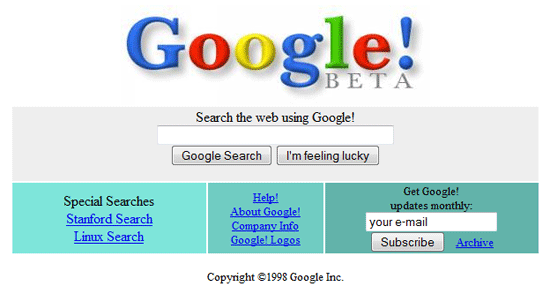
Google went live in 1998, revolutionizing the way in which people find information online.
1998: Internet-based file-sharing gets its roots
In 1998 as well, Napster launched, opening up the gates to mainstream file-sharing of audio files over the internet.
1999: SETI@home project
1999 is the year when one of the more interesting projects ever brought online: the SETI@home project, launched. The project has created the equivalent of a giant supercomputer by harnessing the computing power of more than 3 million computers worldwide, using their processors whenever the screensaver comes on, indicating that the computer is idle. The program analyzes radio telescope data to look for signs of extraterrestrial intelligence.
2000: The bubble bursts
2000 was the year of the dotcom collapse, resulting in huge losses for legions of investors. Hundreds of companies closed, some of which had never turned a profit for their investors. The NASDAQ, which listed a large number of tech companies affected by the bubble, peaked at over 5,000, then lost 10% of its value in a single day, and finally hit bottom in October of 2002.
2001: Wikipedia is launched
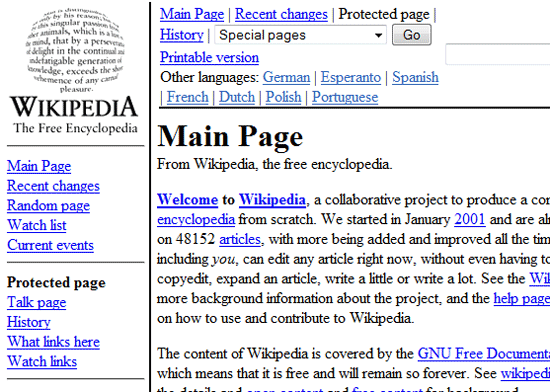
With the dotcom collapse still going strong, Wikipedia launched in 2001, one of the websites that paved the way for collective web content generation/social media.
2003: VoIP goes mainstream
In 2003: Skype is released to the public, giving a user-friendly interface to Voice over IP calling.
2003: MySpace becomes the most popular social network
Also in 2003, MySpace opens up its doors. It later grew to be the most popular social network at one time (thought it has since been overtaken by Facebook).
2003: CAN-SPAM Act puts a lid on unsolicited emails
Another major advance in 2003 was the signing of the Controlling the Assault of Non-Solicited Pornography and Marketing Act of 2003, better known as the CAN-SPAM Act.
2004: Web 2.0
Though coined in 1999 by Darcy DiNucci, the term "Web 2.0", referring to websites and Rich Internet Applications (RIA) that are highly interactive and user-driven became popular around 2004. During the first Web 2.0 conference, John Batelle and Tim O’Reilly described the concept of "the Web as a Platform": software applications built to take advantage of internet connectivity, moving away from the desktop (which has downsides such as operating system dependency and lack of interoperability).
2004: Social Media and Digg
The term "social media", believed to be first used by Chris Sharpley, was coined in the same year that "Web 2.0" became a mainstream concept. Social media–sites and web applications that allow its users to create and share content and to connect with one another–started around this period.

Digg, a social news site, launched on November of 2004, paving the way for sites such as Reddit, Mixx, and Yahoo! Buzz. Digg revolutionized traditional means of generating and finding web content, democratically promoting news and web links that are reviewed and voted on by a community.
2004: "The" Facebook open to college students

Facebook launched in 2004, though at the time it was only open to college students and was called "The Facebook"; later on, "The" was dropped from the name, though the URL http://www.thefacebook.com still works.
2005: YouTube – streaming video for the masses
YouTube launched in 2005, bringing free online video hosting and sharing to the masses.
2006: Twitter gets twittering
Twitter launched in 2006. It was originally going to be called twittr (inspired by Flickr); the first Twitter message was "just setting up my twttr".
2007: Major move to place TV shows online
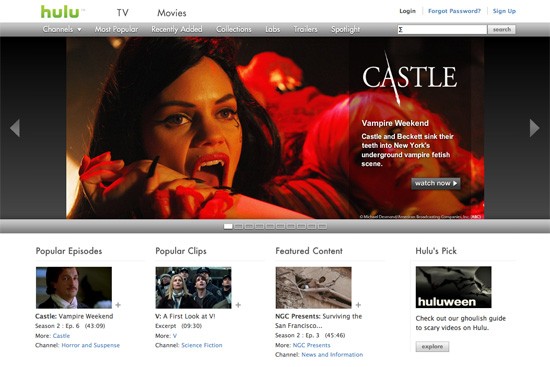
Hulu was first launched in 2007, a joint venture between ABC, NBC, and Fox to make popular TV shows available to watch online.
2007: The iPhone and the Mobile Web
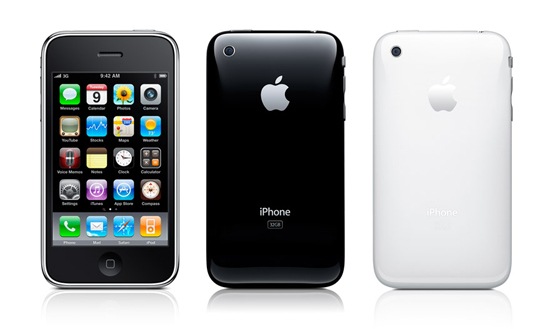
The biggest innovation of 2007 was almost certainly the iPhone, which was almost wholly responsible for renewed interest in mobile web applications and design.
2008: "Internet Election"
The first "Internet election" took place in 2008 with the U.S. Presidential election. It was the first year that national candidates took full advantage of all the Internet had to offer. Hillary Clinton jumped on board early with YouTube campaign videos. Virtually every candidate had a Facebook page or a Twitter feed, or both.
Ron Paul set a new fundraising record by raising $4.3 million in a single day through online donations, and then beat his own record only weeks later by raising $4.4 million in a single day.
The 2008 elections placed the Internet squarely at the forefront of politics and campaigning, a trend that is unlikely to change any time in the near future.
2009: ICANN policy changes
2009 brought about one of the biggest changes to come to the Internet in a long time when the U.S. relaxed its control over ICANN, the official naming body of the Internet (they’re the organization in charge of registering domain names).
The Future?
Where is the future of the Internet headed? Share your opinions in the comments section.
Sources and Further Reading
- A People’s History of the Internet: from Arpanet in 1969 to Today: A timeline of the Internet from guardian.co.uk.
- History of the Internet: An early timeline of the Internet, from precursors in the 1800s up through 1997.
- A Brief History of the Web: A series of videos from Microsoft to celebrate the launch of Internet Explorer 8.
- The History of the Internet – Tim Berners-Lee: A brief history of major developments associated with the Internet from About.com.
- Hobbes’ Internet Timeline – the definitive ARPAnet & Internet History: A very thorough timeline of the Internet, starting in 1957 and going up through 2004, with tons of statistics and source material included.
- Internet Timeline: A basic timeline of Internet history from FactMonster.com.
Related Content
- The History of Web Browsers
- Popular Search Engines in the 90’s: Then and Now
- 10 Revealing Infographics about the Web
- Related categories: Web Development and Infographics
About the Author
 Cameron Chapman is a professional web and graphic designer with over 6 years of experience in the industry. She’s also written for numerous blogs such as Smashing Magazine and Mashable. You can find her personal web presence at Cameron Chapman On Writing. If you’d like to connect with her, check her out on Twitter.
Cameron Chapman is a professional web and graphic designer with over 6 years of experience in the industry. She’s also written for numerous blogs such as Smashing Magazine and Mashable. You can find her personal web presence at Cameron Chapman On Writing. If you’d like to connect with her, check her out on Twitter.
